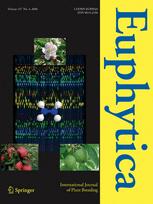Ver ítem
- xmlui.general.dspace_homeCentros Regionales y EEAsCentro Regional Buenos Aires NorteEEA San PedroArtículos científicosxmlui.ArtifactBrowser.ItemViewer.trail
- Inicio
- Centros Regionales y EEAs
- Centro Regional Buenos Aires Norte
- EEA San Pedro
- Artículos científicos
- Ver ítem
Significant effect of accidental pollinations on the progeny of low setting Prunus interspecific crosses
Resumen
The incidence of fortuitous pollination on interspecific hybridizations of the plum rootstock Myrobalan with the apricot cultivars ‘Moniquí’ and ‘Moniquí Borde’ was assessed in this work. Progeny was originated through hand pollination of emasculated flowers of three Myrobalan clones, without bagging, in 1998 and 1999. Fruit set was low and variable among years (1.8–8.0%), but higher than the level of accidental pollination measured with emasculated and
[ver mas...]
The incidence of fortuitous pollination on interspecific hybridizations of the plum rootstock Myrobalan with the apricot cultivars ‘Moniquí’ and ‘Moniquí Borde’ was assessed in this work. Progeny was originated through hand pollination of emasculated flowers of three Myrobalan clones, without bagging, in 1998 and 1999. Fruit set was low and variable among years (1.8–8.0%), but higher than the level of accidental pollination measured with emasculated and non-pollinated flowers (1.2%). Molecular characterization of the progeny was performed with three SSR markers showing that only 28% of the seedlings, obtained by in vitro germination and culture of immature embryos, were hybrids. This represents a lower percentage than expected, and is explained here by the low viability of hybrid embryos and seedlings. The use of molecular markers is discussed in terms of a convenient method for an early identification of putative hybrids in breeding programs with low setting crosses, where the proportion of non-hybrids is magnified.
[Cerrar]

Autor
Arbeola, Arancha;
Daorden, Maria Elena;
García, Elena;
Wünsch, Ana;
Hormaza, José Ignacio;
Marin, Juan Antonio;
Fuente
Euphytica 147 (3) : 389-394 (Feb. 2006)
Fecha
2006
Editorial
Springer
ISSN
0014-2336
Formato
pdf
Tipo de documento
artículo
Palabras Claves
Derechos de acceso
Restringido
 Excepto donde se diga explicitamente, este item se publica bajo la siguiente descripción: Creative Commons Attribution-NonCommercial-ShareAlike 2.5 Unported (CC BY-NC-SA 2.5)
Excepto donde se diga explicitamente, este item se publica bajo la siguiente descripción: Creative Commons Attribution-NonCommercial-ShareAlike 2.5 Unported (CC BY-NC-SA 2.5)

